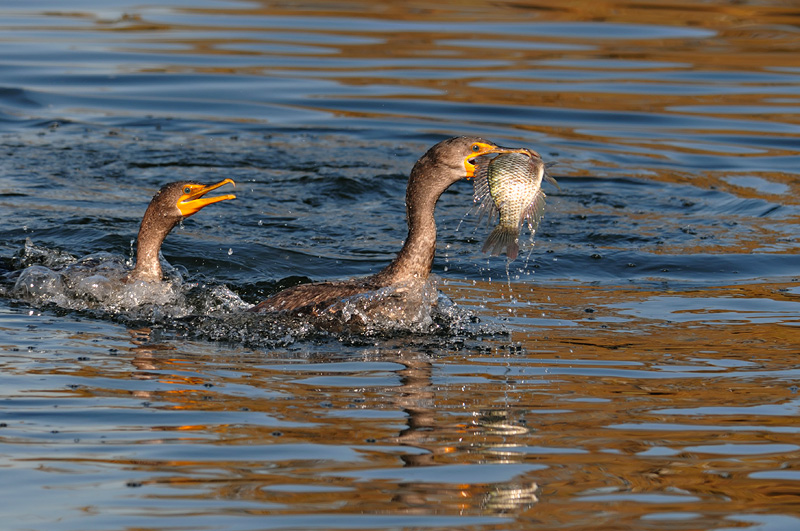As I was reading The New York Times International Weekly newspaper 3 days ago, an article caught my attention. Here's a summary of what the article reported:
When hydroelectric dams were built along the Columbia River, salmon populations plunged. Their movements along the river was hindered and restricted by the dams, and many were killed by the dam's turbines (Barringer, 2014). To revive the salmon population, habitat restoration projects were carried out, and salmon population numbers grew. However, this resulted in an increase in cormorants feeding on the salmon in the Columbia River. Many techniques were used to discourage these birds from feeding juvenile salmon, but efforts were futile. Now, the Army Corp has decided to shoot these birds dead in order to protect the salmon, and this method has stirred up a cloud of controversy.
 |
| BONNEVILLE DAM. PHOTO: HTTP://WWW.OREGONLIVE.COM/ENVIRONMENT/INDEX.SSF/2008/07/COLUMBIA_BASIN_RIVER_MANAGERS.HTML |
These salmon are like well-pampered children. It seems like their predators more or less end up losing their lives. Since 2008, around 60 salmon-eating sea lions have been killed near the Bonneville Dam in the Columbia River (Barringer, 2014). Now, it's the cormorants' turn.
Scientists came to a consensus that current cormorant populations should be slashed by almost two-thirds in order to protect the salmon population (Barringer, 2014), and if shooting starts in 2015, up to 4000 birds will be killed each year till 2018. Already, the Army Corps has acquired permits to conduct killing of up to 150 double-crested cormorants each year at five dams along the Columbia River (Flatt, 2014),
Here's the catch. 13 of 19 salmon populations in the Columbia River have been listed either as threatened or endangered (Barringer, 2014). Thus, they can be considered as being conservation reliant, needing humans' intervention to ensure its perpetuation. On the other hand, the cormorants are not listed as endangered or threatened under the Endangered Species Act. Does that mean this act of killing the salmon-eating birds is justified? Is it fair that the building of dams by humans have upset the salmon population, and yet the birds are paying the price for it? Ironically, these birds can be considered as under human intervention, albeit to reduce their population, not conserve them.
 |
| LUNCH TIME FOR THE CORMORANTS. PHOTO: HTTP://WWW.GRAHAMOWENGALLERY.COM/PHOTOGRAPHY/CORMORANTS.HTML |
Certain species are conservation reliant, and warrants human intervention and protection to survive. In the case of salmon, the building of hydroelectric dams reduced salmon populations, and so it is right for us to take responsibility to protect them from extinction. I understand that the cormorants are in a way, interfering with humans' attempt to conserve the salmon population. However, it should be noted that both cormorants and salmon live in the wild, and this predator-prey relationship (birds eating the fishes) was established way back in the past. To kill the birds feels like we're interfering with nature.
Perhaps instead of focusing on how to prevent salmon from being eaten up, we can turn our attention to how we can protect salmon from death due to human activities. Engineers should take into account salmon populations when constructing dams, and design them in such a way that salmon do not get anywhere close to the turbines, or avoid the dam altogether (Thompson, 2014). Regulating the strength of water flowing, eliminating gaps between turbines that could trap fishes, having smooth surfaces in areas that may be exposed to fish contacts are just some of the ideas mooted and implemented in newly constructed dams. The authorities can consider modifying the dams along Columbia River, and hopefully, circumvent the need to kill the cormorants.
Literature Citied
Barringer, F. (2014) Taking Up Arms Where Birds Feast on Buffet of Salmon. The New York Times. [ONLINE] 15 August. Available at: http://www.nytimes.com/2014/08/16/us/taking-up-arms-where-birds-feast-on-buffet-of-salmon.html?_r=0. [Accessed 13 September 14].
Thompson, E. (2014) Engineering a More Fish-Friendly Dam. Illumin. [ONLINE] Available at:
http://illumin.usc.edu/printer/29/engineering-a-more-fish-friendly-dam/. [Accessed 13 September 14].
No comments:
Post a Comment